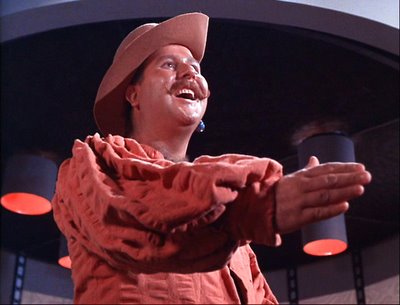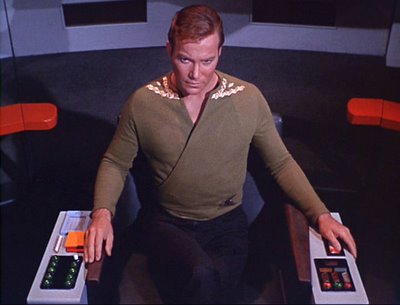"Mudd's Women"
As I realized when I began plotting "The Trektastic Voyage," I knew real life would intervene. Family time and rest pushed back my Trek viewing until late Friday night, and it isn't until now on Saturday morning that I'm able to update the first epidode's entry and post it. The entry for the second episode will follow on Sunday. My goal is to get the week's episodes watched and then commented on before Monday, so I'm still in the green.
The first episode in this week's installment of "The Trektastic Voyage" is "Mudd's Women," one of the series's first comedic entries which served to introduce that most beloved of space pirates, Harcourt Fenton Mudd.
The Enterprise saves the crew of a small vessel that happens into an asteroid field. Kirk quickly learns that her captain is one Leo Wallace, later revealed by the Enterprise's computer scanners to be intergalactic con man Harry Mudd, who has a list of priors as long as his arm. As Mudd informs Kirk, the three beautiful women who were with him on the ship were his cargo, not his crew. The women have an almost pheromonal effect on the male crewmembers of the Enterprise, including Kirk and even Spock. Mudd was taking the women to become the wives of farmers on a distant outpost. The Enterprise burned out a few of her lithium crystals in the process of extending her shields around Mudd's ship, and without them, the Enterprise will soon be completely powerless. Kirk orders the ship to an ore processing plant on Rigel XII, where the necessary crystals can be found. We quickly learn that Mudd's women derive their beauty from the illegal Venus drug. Once at the ore station, Mudd arranges a deal with the miners: the women for amnesty from Kirk and justice. In the end, the women learn that the drug wasn't the source of the powers. Instead, as Kirk explains, we are who we make ourselves to be. The marriages work out between the settlers and the Enterprise continues boldy going, replenished with new crystals.
"Mudd's Women" was written by series creator Gene Roddenberry, and while remaining a fan favorite to this day, has a few oddities. Certainly, there's a bit of sexism in the way the miners regard the women, as well as how the women regard the miners. There's also the odd use of pots and pans by settlers in the 23rd century. The likely excuse for this latter device is Roddenberry's pitch for Star Trek, that it was to be "Wagon Train" in Space. These points do not detract from an episode filled with comedy and fun. Roger C. Carmel does an amazing job as Harry Mudd, and would reprise the role a second and final time in "I, Mudd" in the third season of the show. Mudd is a wonderful foil for the straight-laced, devoted Kirk, who again is portrayed here as a man whose dedication to his ship prevents him from having a normal life. "Mudd's Women" offers a number of laugh out loud moments from Mudd and a love-struck McCoy and Scotty.
Screencaps from "Mudd's Women."
The episode's title card.

The irascible Harry Mudd.

Ah, Mudd's women.

The effect of the space sirens on the Enterprise crew.

Captain Kirk's reaction to the ladies of the spaceways.

Here we see that Nimoy and the writers were still figuring out Spock. He takes obvious delight at Kirk's reaction to the women, sporting an impish grin. These traits would be written completely out of the character not long after this episode.

Yikes! One of Mudd's "lovelies" without their beloved Venus drug.

Kirk and Spock assessing the steady decline of the Enterprise's situation in a classic image of the two characters together.

After realizing that she doesn't need the Venus drug to be beautiful, Eve and her soon-to-be miner husband discuss their future together.

Kirk tries to stay neutral as McCoy picks at Spock's bizarre Vulcan anatomy, as well as his lack of emotions. Bones indicates where Spock's heart is with his left fist.












































